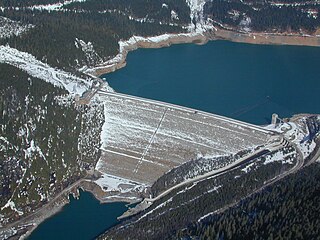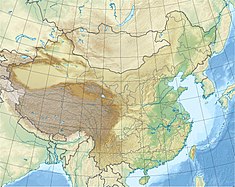
Hydroelectricity is electricity produced from hydropower. In 2015, hydropower generated 16.6% of the world's total electricity and 70% of all renewable electricity, and was expected to increase about 3.1% each year for the next 25 years.

Salal Dam, also known as Salal Hydroelectric Power Station, is a run-of-the-river power project on the Chenab River in the Reasi district of the Indian state of Jammu and Kashmir. The dam construction started after entering mutual agreement between India and Pakistan in 1978.

Nuozhadu Dam is an embankment dam on the Lancang (Mekong) River in Yunnan Province, southwest China. The dam is 261.5 m (858 ft) tall, and creates a reservoir with a normal capacity of 21,749,000,000 m3 (17,632,000 acre⋅ft) at a level of 812 m (2,664 ft) asl. The purpose of the dam is hydroelectric power production along with flood control and navigation. The dam supports a power station with nine generators, each with generating capacity of 650 MW. The total generating capacity of the power station is 5,850 MW. Construction on the project began in 2004; the dam's first generator went online 6 September 2012 and the last generator was commissioned in June 2014. The construction and management of the project was implemented by Huaneng Power International Ltd., which has a concession to build, own and operate hydroelectric dams on China's stretch of the Mekong River.

The Xiaowan Dam is an arch dam on the Lancang (Mekong) River in Nanjian County, Yunnan Province, southwest China. The primary purpose of the dam is hydroelectric power generation and it supports a 4,200 MW power station. Constructed between 2002 and 2010 by Huaneng Power International at a cost of ¥32 billion, it is the world's second highest arch dam at 292 m (958 ft). It is also third highest among dams of all types behind Jinping-I and Nurek and the third largest hydroelectric power station in China.

The Vau i Dejës Hydroelectric Power Station is a hydroelectric dam on the Drin River, in Albania, near Vau i Dejës. Completed in 1973, the project consists of five turbines of Chinese origin, each with a nominal capacity of 52 MW, totaling the installed capacity to 260 MW.

The Hatanagi-II is a dam on the Ōi River in Aoi-ku, Shizuoka, Shizuoka Prefecture on the island of Honshū, Japan. A hollow-core concrete gravity dam, it has a hydroelectric power generating station owned by the Chubu Electric Power Company.

The Tianshengqiao-II Dam is a dam and hydroelectric power station on the Nanpan River in the Anlong and Longlin districts in China. Construction of the dam and power plant began in 1982 and was complete in 1997.

The Longyangxia Dam is a concrete arch-gravity dam at the entrance of the Longyangxia canyon on the Yellow River in Gonghe County, Qinghai Province, China. The dam is 178 metres (584 ft) tall and was built for the purposes of hydroelectric power generation, irrigation, ice control and flood control. The dam supports a 1,280 MW power station with 4 x 320 MW generators that can operate at a maximum capacity of 1400 MW. Controlling ice, the dam controls downstream releases to reservoirs lower in the river, allowing them to generate more power instead of mitigating ice. Water in the dam's 24.7 billion m3 reservoir provides irrigation water for up to 1,000,000 hectares of land.

The Baishan Dam is an arch-gravity dam on the Second Songhua River near the town of Baishanzhen, Huadian, Jilin Province, China. The purpose of the dam is hydroelectric power generation and flood control. The dam supplies water to five turbine-generators in two different powerhouses for an installed capacity of 1,500 megawatts (2,000,000 hp) while it can also control a design 19,100 cubic metres per second (670,000 cu ft/s) flood. Additionally, it has a 300 megawatts (400,000 hp) pumped-storage hydroelectric generation capacity. It is named after Baekdu Mountain, near the city of Baishan.

The Zimapán Dam, also known as Fernando Hiriart Balderrama Dam, is an arch dam on the Moctezuma River about 15 km (9 mi) southwest of Zimapán in Hidalgo state, Mexico. The primary purpose of the dam is hydroelectric power production and it services a 292 MW power station with water.

The Jinping-I Dam also known as the Jinping-I Hydropower Station or Jinping 1st Cascade, is a tall arch dam on the Jinping Bend of the Yalong River in Liangshan, Sichuan, China. Construction on the project began in 2005 and was completed in 2014. Its power station has a 3,600 MW capacity to produce between 16 and 18 TW·h annually. Supplying the power station is a reservoir created by the 305-meter-tall arch dam, the tallest in the world. The project's objective is to supply energy for expanding industrialization and urbanization, improve flood protection, and prevent erosion.

The Dharasu Power Station is a run-of-the-river hydroelectric power station on the Bhagirathi River located at Dharasu in Uttarkashi district, Uttarakhand, India. The power station was commissioned in 2008 and has a 304 MW capacity.

The Jilintai I Dam is a concrete-face rock-fill embankment dam on the Kash River, 29 km (18 mi) east of Nilka in Xinjiang, China. The dam was constructed between 2001 and 2005 for several purposes but mainly hydroelectric power generation. It supports a 460 MW power station. The Jilintai I is the first of 10 dam projects on the Kash. Construction of Jilintai II, directly downstream, begin in May 2008 and the 50 MW power station was commissioned in October 2010. The project, including the diversion dam, was complete in April 2011.

The Malutang Dam is a concrete-face rock-fill dam (CFRD) on the Panlong River in Malipo County, Yunnan Province, China. The primary purpose of the dam is hydroelectric power generation and the power plant was constructed in two stages. Stage I consists of a 40 m (131 ft) tall gravity dam which diverted water through a 3,460 m (11,352 ft) long tunnel to a 100 MW above ground power station downstream. Construction on Stage I began in 2002 and the first of 50 MW Francis turbine-generators was commissioned in October 2004, the second in January 2005. Stage II was the construction of a 156 m (512 ft) tall CFRD 200 m (656 ft) downstream of the Stage I dam. Stage II's power station contains three 100 MW Francis turbine generators. Construction on Stage II began in August 2005 and the reservoir began to fill in October 2009. In December 2009, the first 100 MW generator was operational and the last two by May 2010. Malutang Dam's reservoir submerged the Stage I dam but the Stage II intake tower receives water for both stages, allowing Stage I to continue to operate.
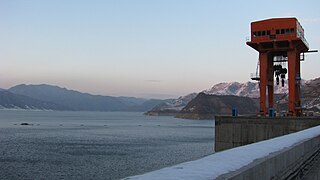
The Unbong Dam, or Yunfeng Dam, is a concrete gravity dam on the Yalu River which borders China and North Korea. It is located 33 km (21 mi) northeast of Ji'an in Jilin Province, China and Chasŏng in Chagang Province, North Korea. The primary purpose of the dam is hydroelectric power generation and it supports a 400 MW power station. Construction of the dam had initially began in August 1942 but was halted in 1945 after the surrender of Japan ending World War II. In October 1959, construction on the dam recommenced and in September 1965, the first of the four 100 MW Francis turbine-generators was operational. The last generator was operational on 4 April 1967. The 113.75 m (373 ft) tall dam creates a reservoir with a storage capacity of 3,895,000,000 m3 (3,157,728 acre⋅ft). The dam's spillway is an overflow type with 21 floodgates and has a maximum discharge of 21,900 m3/s (773,391 cu ft/s). The dam is located before a bend in the river and its power station is located on the other side of a ridge that meets the dam’s right abutment. Water is delivered to the power station via two tunnels, 775 m (2,543 ft) and 759 m (2,490 ft) long. Generators 1 and 3 deliver power to China while 2 and 4 deliver to North Korea.
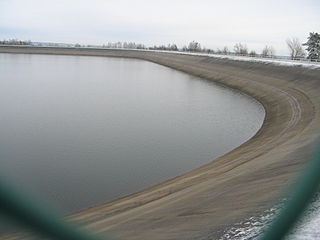
The Coo-Trois-Ponts Hydroelectric Power Station is a pumped-storage hydroelectric power station located in Trois-Ponts, Province of Liege, Belgium. Located next to the Amblève River, the power station uses its water to support a power scheme where water is pumped from a lower reservoir to one of two upper reservoirs known as Coo I and Coo II. When energy demand is high, water can be released from these reservoirs for power generation. The water then returns to the lower reservoir and the process repeats as needed. The same machines that pump the water to the upper reservoirs at a higher elevation are also used as generators. The plant was commissioned in two stages, Coo I (1969) and Coo II (1978). It is owned by Electrabel and has an installed capacity of 1,164 MW.
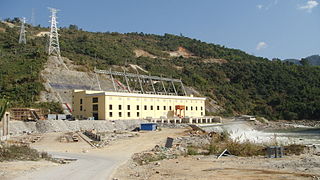
The Shweli I Dam is a gravity dam on the Shweli River about 23 kilometres (14 mi) southwest of Namhkam in Shan State, Burma. The primary purpose of the dam is hydroelectric power generation and it supports a 600 megawatts (800,000 hp)power station. Water from the dam's reservoir is diverted through a 5.1 kilometres (3.2 mi) long headrace tunnel to the power station downstream. The drop in elevation affords a hydraulic head of 299 metres (981 ft). Construction on the dam began in 2002 and the river was diverted on 10 December 2006. On 5 September 2008, the first generator was commissioned and the last of the six was commissioned in April 2009. The dam and power station was constructed under the build–operate–transfer method and cost US$756.2 million. It is owned and operated by the Shweli River-I Power Station Co. The Shweli II and Shweli III Dams are planned downstream.

Trebinje I Hydroelectric Power Station or Trebinje-1 Hydroelectric Power Station is hydroelectric power plant (HPP)on the Trebišnjica River near Gornje Grančarevo in the municipality of Trebinje in Bosnia and Herzegovina. Trebinje-1 HPP is accumulation with dam toe powerhouse type of facility with a large Grančarevo arch dam. At the height of 123 m (404 ft), Grančarevo dam is the tallest dam in the country. Its reservoir, Bileća Lake, is the largest by volume in Bosnia and Herzegovina as well. The dam provides for flood control and hydroelectric power generation at Trebinje-1 HPP. The dam was completed in 1967 and its 180 MW power station, A smaller 8 MW power station, Treblinje-2, was completed downstream in 1979.
TSQ is 6-Methoxy-(8-p-toluenesulfonamido)quinoline, one of the most efficient fluorescent stains for zinc(II).
